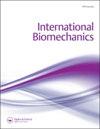垒球运动员腰骨盆-髋关节复合体不稳定性及节段序列的评估
Q2 Medicine
引用次数: 6
摘要
摘要:本研究的目的是研究腰骨盆-髋关节复合体(LPHC)不稳定性对头顶投掷过程中节段序列和最大速度的影响。50名垒球运动员(身高164.0±104.0厘米,体重65.6±11.3公斤,年龄16.3±3.8岁)被分为大学、高中和青少年,他们进行了3次60英尺的头顶投掷,然后进行了双侧单腿深蹲(SLS)。运动学用电磁跟踪系统记录。如果参与者在SLS下降阶段膝关节屈曲45°时膝关节外翻大于15°,则被归类为“不稳定”。单因素方差分析和Bonferonni事后检验显示,在大学、高中和青年参与水平上,稳定组之间在片段排序和最大速度方面没有显著差异。当所有运动员不分年龄分组时,各组之间仍然没有观察到显著差异。这些发现表明,在这一特定的运动员群体中,段序和最大速度并不是LPHC稳定性的函数。此外,SLS可能无法准确量化LPHC在投掷方面的稳定性。作者建议未来的研究在不同的运动人群中重复这些方法,并继续评估LPHC稳定性的不同临床试验。本文章由计算机程序翻译,如有差异,请以英文原文为准。
Assessment of lumbopelvic–hip complex instability and segmental sequencing amongst softball athletes
ABSTRACT The purpose of this study was to examine the effects of lumbopelvic–hip complex (LPHC) instability on segmental sequencing and the maximum velocities during the overhead throw. Fifty softball athletes (164.0 ± 104.0 cm, 65.6 ± 11.3 kg, 16.3 ± 3.8 years) classified as either college, high school or youth performed three 60 ft overhead throws then executed bilateral single leg squats (SLS). Kinematics were recorded using an electromagnetic tracking system. Participants were classified as ‘unstable’ if they displayed knee valgus greater than 15° at 45° knee flexion in the descending phase of the SLS. One-way ANOVAs and Bonferonni post-hoc tests revealed no significant differences between stability groups in segmental sequencing and maximum velocities amongst the college, high school and youth participation level. When all athletes were grouped together regardless of age, there were still no significant differences observed between groups. These findings imply that segmental sequencing and maximum velocities are not a function of LPHC stability amongst this specific group of athletes. Additionally, the SLS may not accurately quantify LPHC stability in regards to throwing. The authors recommend that future studies repeat these methods amongst different athletic populations and continue to evaluate different clinical tests for LPHC stability.
求助全文
通过发布文献求助,成功后即可免费获取论文全文。
去求助
来源期刊

International Biomechanics
Medicine-Rehabilitation
CiteScore
1.90
自引率
0.00%
发文量
2
审稿时长
17 weeks
期刊介绍:
International Biomechanics is a fully Open Access biomechanics journal that aims to foster innovation, debate and collaboration across the full spectrum of biomechanics. We publish original articles, reviews, and short communications in all areas of biomechanics and welcome papers that explore: Bio-fluid mechanics, Continuum Biomechanics, Biotribology, Cellular Biomechanics, Mechanobiology, Mechano-transduction, Tissue Mechanics, Comparative Biomechanics and Functional Anatomy, Allometry, Animal locomotion in biomechanics, Gait analysis in biomechanics, Musculoskeletal and Orthopaedic Biomechanics, Cardiovascular Biomechanics, Plant Biomechanics, Injury Biomechanics, Impact Biomechanics, Sport and Exercise Biomechanics, Kinesiology, Rehabilitation in biomechanics, Quantitative Ergonomics, Human Factors engineering, Occupational Biomechanics, Developmental Biomechanics.
 求助内容:
求助内容: 应助结果提醒方式:
应助结果提醒方式:


